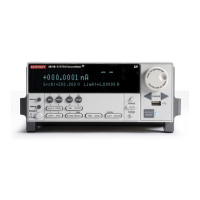10-10 Return to Section Topics 2600S-901-01 Rev. C / January 2008
Section 10: Digital I/O and Triggering Series 2600 System SourceMeter® Instruments Reference Manual
TSP-Link Synchronization lines
The Series 2600 System SourceMeter
®
has three synchronization lines that you can use for
triggering, digital I/O, and to synchronize multiple instruments on a TSP-Link network.
Connecting to TSP-Link
The TSP-Link synchronization lines are built into TSPLink. Use the TSP-Link connectors located
on the back of the Series 2600 SourceMeter. If you use the TSP-Link network, you do not have to
modify your connections. See,
“System Expansion (TSP-Link),” page 9-1 for detailed information
about connecting to TSP-Link.
Digital I/O
Each synchronization line is an open-drain signal. When using the TSP-Link synchronization lines
for digital I/O, any node that sets the programmed line state to 0 causes all nodes to read 0 from
the line state. This occurs regardless of the programmed line state of any other node.
Digital I/O bit weighting
Table 10-3 displays the bit weighting for the digital I/O lines.
Table 10-3
Digital I/O bit weighting
Line # Bit
Decimal
weighting
Hexadecimal
weighting
1
2
3
B1
B2
B3
1
2
4
0x0001
0x0002
0x0004
Remote TSP-Link synchronization line commands
Commands that control and access the TSP-Link synchronization port are summarized in Table
10-4. See Section 12 for complete details on these commands. See Table 10-3 for the decimal and
hexadecimal values used to control and access the digital I/O port and individual lines.
Table 10-4
TSP-Link Triggering commands
Command Description
Commands for basic I/O:
tsplink.readbit(bit)
tsplink.readport()
tsplink.writebit(bit, data)
tsplink.writeport(data)
tsplink.writeprotect = mask
Read one digital I/O input line
Read digital I/O port
Write data to one digital I/O output line
Write data to digital I/O port
Write protect mask to digital I/O port

